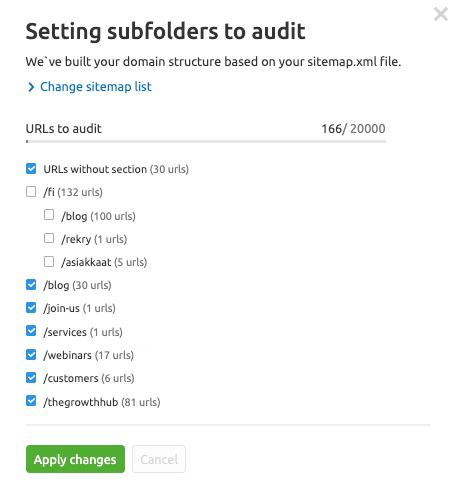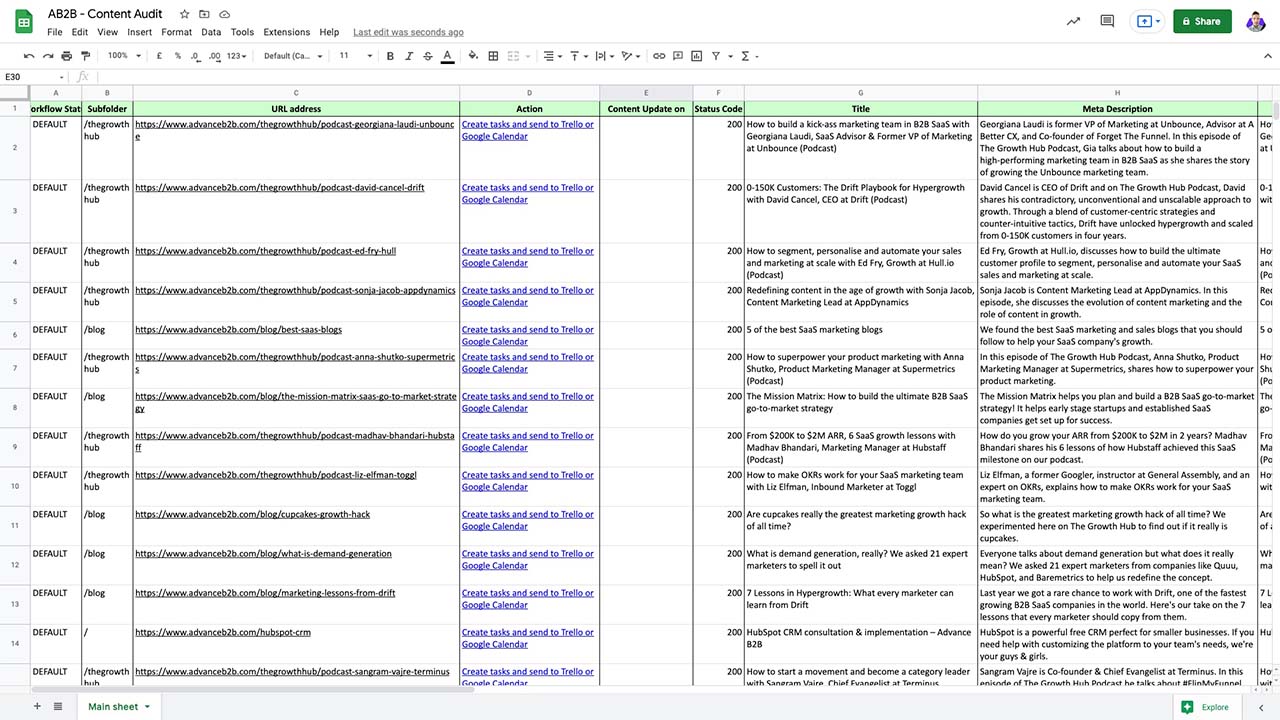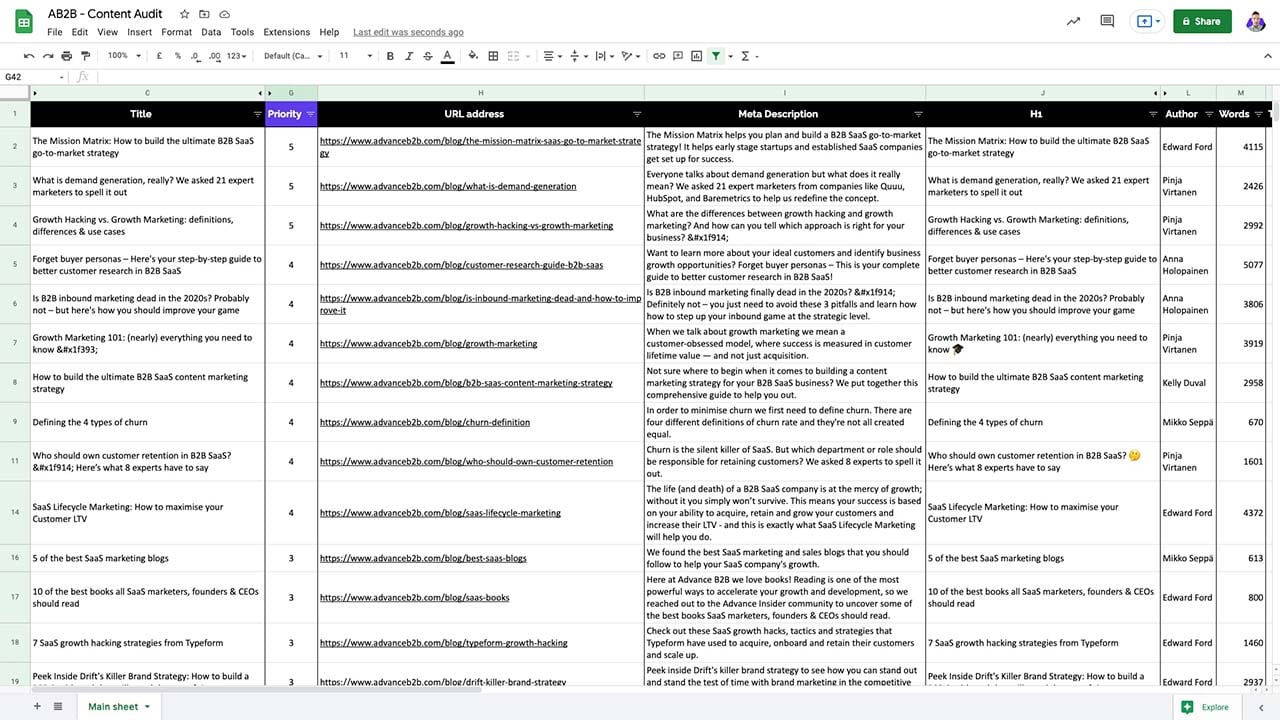Hot take: Too few marketing teams create strategic content aligned with their business goals. And that's a problem.
No strategy means no goals, no action plans, and no way to measure your efforts.
If you lack a documented content strategy or would like to review your process, this article should be helpful.
Table of contents
- What is a content marketing strategy, anyway?
- Why B2B companies need a content marketing strategy
- 10 steps to creating your content marketing strategy
And psst: If you’re interested in this topic, stay tuned for more (and subscribe to our Advance Insider newsletter to make sure you won't miss any future posts!)
What is a content marketing strategy, anyway?
Let’s ensure that we speak the same language and share a definition of what a content marketing strategy is (and what it isn’t).
- A content marketing strategy exists as part of your overall marketing strategy. It should guide all of your content choices and outline the ‘WHY’ for all your content marketing efforts. Simply put, if one of your content efforts doesn’t meet that ‘WHY’, drop it.
- A content marketing strategy is not a content calendar.
One-size-fits-all strategy
There’s no such thing as a one-size-fits-all content marketing strategy.
What works for your closest competitor might not deliver any results for your organization. This is why you won’t find a fill-in-the-blank template here.
For your content marketing strategy to be effective, you need to consider your unique business situation and answer the following questions:
- What do you expect from content marketing, and how can it support your business goals?
- Who is the content for? (spoiler alert: it shouldn’t be “everyone”)
- What type of content should you create?
- What metrics do you use to measure success?
- What topics will you talk about, and how will they help your audience?
- How will you plan, create, and distribute our content?
Content marketing tactics vs. Content marketing strategy
It’s pretty common to see marketers misinterpret tactics from strategy.
- Strategy is the bigger picture. It tells you where you want to go.
- Tactics are the means and actions you follow to fulfill your strategic objectives.
Of course, tactics are more relatable because they are what we do daily. But diving too much into tactics can be dangerous, as it can make you forget WHY you’re doing what you do in the first place. This is why we highly recommend reviewing your strategy at least twice a year to ensure that your tactics and strategy are still aligned.
—
Now that we share a common understanding of what a content marketing strategy is, let me remind you why all B2B companies need it.
Why should all B2B companies build a content marketing strategy?
Companies that create a content marketing strategy see roughly 30% higher growth rates than companies without one.
Content shouldn’t be created in a vacuum.
A content marketing strategy focuses your day-to-day efforts and helps you understand the role content plays in the big picture.
You need to know what you’re trying to accomplish with the content you’re creating. What would be the point otherwise?
For instance, if you just create a few blog posts when the mood strikes, you won’t see the results you hope for (and, therefore, won’t even know what results to expect). You’ll have no way of knowing whether your content resonates with readers or has any impact whatsoever.
A content marketing strategy gets everyone at your company (marketing, sales, product, etc.) on the same page with your content marketing goals. Simply put, it helps you decide what to do, when to do it, and how to do it.
10 steps to building a content marketing strategy that works for you
1. Sync with your marketing strategy
The more you know, the better.
When embarking on your content marketing strategy journey, the first thing to do is ensure that you have a clear understanding of your marketing strategy and its key findings.
That includes:
- Your value proposition
- Your brand positioning and messaging
- Your Ideal Customer Profile (ICP)
While a content marketing strategy can work independently, it will deliver better results as part of your overall marketing strategy.
2. Talk to your ideal customers
How can you create content that can support your business goals without a deep understanding of your ideal customers?
You’ve likely heard this a thousand times before, but because it’s so critical, it forever bears repeating: Know your ideal buyer and create content that speaks to their wants and needs.
This should be your #1 priority.
The best way to find out what motivates your customers and what they need and value is customer research.
Customer research. It’s all about customer research
Sure, you can get a lot of information by analyzing what people do on your website, but if you truly want to put yourself into your buyer’s shoes, you need to speak to them directly.
By interviewing potential, current, and past customers, you’ll get a real sense of who your target audience is, what problems they’re facing, what solution they are looking and, therefore, how you can help them with on-point content.
It’s about time we let go of persona.
The buyer persona used to be the alpha and the omega of any marketing action.
You might find it controversial, but we firmly believe that the persona is dead. It wrongly places people in boxes based on who they are, but it doesn’t tell you anything about what they need.
You want to go beyond the superficial demographics like age, gender, and profession. You want to understand their needs in relation to the solution you’re offering. In other words, you want to aim for less “Marketing Mary” and more insights on your real-life customers.
What’s truly important is figuring out your customers’ struggles. What causes them to seek out solutions and make a specific purchase? These struggles can also be called “jobs to be done”—you can use the jobs-to-be-done framework to conduct better customer research.
- To define this, let me refer to Clayton Christensen—the man behind the Jobs to Be Done framework. “The theory of Jobs to Be Done is a framework for better understanding customer behavior. While conventional marketing focuses on market demographics or product attributes, Jobs Theory goes beyond superficial categories to expose the functional, social, and emotional dimensions that explain why customers make the choices they do.”
At the risk of repeating myself, you need to talk to your customers to understand what jobs they are truly hiring your company to do. This is the only way you’ll get at the causal driver behind their purchases.
There’s often a disconnect between what a B2B company thinks its customers are interested in and what its customers actually need and value. This disconnect is natural because B2B companies are rarely their own ideal customers.
—
Only when you know your audience’s struggles will you be able to create content that speaks to them. Find the questions your current and future customers ask and answer them.
3. Set goals that support your business
Without concrete and relevant goals, your content will be useless.
Clearly display what you’re trying to achieve, may it be awareness generation, lead generation, education, ... you name it, and ensure everyone on your team understands this goal.
Marketing and sales alignment cannot be overstated, as you can only set meaningful KPIs and metrics to measure success in content marketing once you know your overall business goals.
Say you have a no-touch sales model and want to increase paid subscriptions to your SaaS. To reach this goal, you could aim at creating more content to show the value of your solution and educate your audience with the objective of turning users into qualified leads or, better, paying customers.
On the other hand, if your main goal is to generate awareness, the metrics will look different—you’ll focus on addressing burning topics that keep your ICP up at night to appear on their radar.
How to measure your content marketing efforts
Measure what matters (vs. measuring vanity metrics).
The only way to know how well your strategy is working is by tracking relevant indicators.
Vanity metrics such as the number of likes your latest tweet received or that one spike of traffic you received three months ago can be flattering, but they are NOT valuable if they aren’t aligned with your strategic goals.
Again, we don’t have a one-size-fits-all list to give you, as what you measure should entirely depend on what you are trying to achieve.
4. Establish an editorial mission
What do you want to achieve with your content? Who are you trying to reach, and how will you get to them?
These are the questions your editorial mission (also called a content marketing mission) will answer. Without a clear mission, you’re writing for the sake of writing. And that simply isn’t content marketing.
All your content should be created with one goal in mind: to help your audience succeed in their jobs. This is why deeply knowing your audience is vital.
Your editorial mission is a key piece of your content marketing strategy that guides all content planning and production.
It helps:
- focus your efforts as your team grows,
- align all your writers,
- prioritize what type of content to create (and what not to create).
Finally, make sure everyone involved in content marketing can access your editorial mission.
5. Run a content audit to assess your current (content) situation
To get where you want to go, you first need to take a snapshot of your current situation.
The next step is to run a content audit and get actionable insight into the current state of all your web content.
This will tell you what content is performing best and what content your audience appreciates the most so you’ll know where to focus your efforts.
In short, beyond giving you a picture of all the content of your website, a content audit should tell you:
- What is your content about?
- Who is your content targeting?
- How mature should your audience be to enjoy your content?
- How is your content performing?
- What are the top keywords your content is ranking on?
- What type of content are you missing?
- What are the content pieces you should update, merge, or simply delete?
The above information is necessary to produce a working content marketing strategy.
Now, how does one run a content audit? Here again, there’s no one-size-fits-all process. But generally, you’ll follow these three basic steps:
1. Export your data
The first step is to export your data. This can be done in a couple of clicks using tools such as SemRush, Ahrefs, or Moz. To get all the information you need, make sure you connect your Google Analytics and Google Search Console accounts, whatever tool you end up using.

The data you export should tell you everything you need to know about each piece of content’s performance, from the # of visits to the top keywords and average CTR on Google search.
Of course, you could do this manually if your website only contains a couple of dozen pages. Above that, using a tool will make the process much faster.
2. Aggregate your data
As comprehensive as it can be, the data you export is only as valuable as your ability to understand it.
Let me illustrate this.
Here’s what you’d get from a tool like SemRush

Informative? Sure. But also not usable as is.
You need to be able to tell the story behind the data.
Take the time to read every piece of content and categorize it based on its position in your funnel and who it is meant for. This is the most tedious (and critical) part of the process.
Once you’re done, you can even create a priority score to grade your content and focus your attention on the pieces that will have the most impact on your business.

3. Draw conclusions and create a plan of action
Once you’re done aggregating your data, you should have a clear picture of your current content situation and have the answer to questions like:
- How much of your content is Top of Funnel (ToFu), Middle of Funnel (MoFu), or Bottom of Funnel (BoFu)?
- What are the topics you address the most?
- What are the topics you address the least?
- How old is your content? (and how much of it needs an update?)
- etc.
Based on your assessments, create action plans for each piece of content. Provide recommendations for improving your content according to:
- User-friendliness (structure, navigation, content, voice & tone, readability)
- Business goals (increasing organic traffic, increasing the number and quality of leads)
Will you add new internal links to older blog posts? Should you update the CTAs to replace irrelevant or outdated ones? Reuse a well-performing piece of content or publish it in a new format?
If you already have a content marketing strategy, conducting a content audit helps you assess how it’s currently working. And if you don’t, you can build your strategy based on the findings of your audit.
Content optimization vs. content creationThe more content legacy you have, the more valuable the audit exercise. Creating relevant content is key to meeting your audience. But it shouldn’t be your sole focus. Even if you didn’t follow a thorough content marketing strategy in the past, it is likely that you and your content team did produce quality and relevant content. If so, update it! |
6. Choose a content framework
A content framework represents the ‘HOW’ of content creation. How will you organize content on your website and optimize it for search?
There are a few different frameworks you can use to manage your content, including:
- Topic clusters
- Blog categories
- Content format-driven hubs
The topic cluster approach has many benefits, including increasing organic traffic. Applying this framework allows you to think of your blog as a library of information rather than a publication. As Jimmy Dally writes, “Content that lives alone dies alone.” You want to build a vast library of information that will earn traffic well into the future.
Depending on your business and goals, the topic cluster approach may not always work best. But whatever framework you choose, quality and depth are better than volume and breadth. Rather than cover a broad range of topics on a superficial level, you want to create substantial content that will provide more value to your audience.
7. Choose the right content themes and formats
What are you writing about, and does it make sense for your business?
Choosing the right content themes (or topics) ensures all your content fits into both your short- and long-term goals. All content themes should tick the following boxes:
- Your target audience is interested in the theme
- The theme is consistent with your company’s offering
- The theme is close enough to your business to make the connection seem natural
- The theme is broad enough to allow producing at least ten stand-alone cluster pieces
- You have the domain authority to rank for the base search term (e.g., “organizational development”)
When creating a new content piece, you want to know what part of the buyer’s journey it’s for and identify specific KPIs.
Meet the AAARRR funnel (or Pirate funnel 🏴☠️):
Awareness
How do you reach your target audience?
Acquisition
How do you get your target audience to visit your website?
Activation
How do you turn visitors into contacts or users?
Revenue
How do you turn contacts and users into customers?
Retention
How do you get customers to stick around for a while?
Referral
How do you motivate your customers to recommend your organization or product to their peers?
You also want to make sure each theme supports your end goal of converting visitors by having a natural conversion point like an associated eBook or landing page.
- Read more: A deep dive into the AAARRR funnel
8. Find and maintain your brand personality
Brand plays a significant role in the success of your B2B company. We often tell our customers that, given enough time and resources, anyone can copy a product. Copying a brand, however, is close to impossible.
SaaS brands report having an average of 9.7 competitors and are starting to invest more in their brands to stand out in a crowded market.
Why? Because brand, not features, is the biggest differentiator.
Your brand is essentially how your audience perceives you. And your voice is the representation of your brand personality. Even if you don’t take the time to define your brand, your audience will still form an impression of you.
Of course, establishing your brand’s unique personality and tone of voice is no easy feat. It’s not something you can whip up overnight. It’s essential to take the time to involve key stakeholders in your company and get everyone on the same page.
When refining your brand personality and voice, ask yourself the following questions:
- If your brand were a person, how would you describe them?
- If your brand were an emoji, what would it be?
- How do you want people to feel when they visit your site and read your content?
- What brand voices do you admire, and which do you dislike? Why?
Keeping a consistent tone with everything you write is crucial to building trust with your audience. To nail down your tone of voice, you can also complete these two exercises developed by the Nielsen Norman Group with your team.
9. Distribute and amplify your content
You cannot expect your content to perform if you don’t spread the news yourself.
Don't let all your content creation efforts go to waste by failing to distribute and promote it.
Distribution shouldn’t just be an afterthought. Instead, it should be built into the planning phase of every content piece.
How will you reach your audience? There are a few ways to distribute your content:
Search Engine Optimization (SEO)
A well-written blog post or insightful podcast isn’t the only key to content marketing success. You need to optimize your content for search so that the right people can find it. Your SEO strategy will depend on your primary business goals—for example, are you trying to increase awareness or boost conversions and sign-ups?
By taking a pain-point-driven SEO strategy rather than a keyword-first approach, you’ll be well-equipped to come up with topics that generate leads and increase conversions.
Organic social distribution
Based on your customer research, you’ll know where your ideal buyers hang out online. Your content marketing strategy doesn’t need to include a strict channel plan, but you can discuss some of the most important ones. Share content on these channels and interact with your audience there.
You’ll also want to leverage your and your team’s personal networks. People generally prefer following individuals over companies on social media. Keep in mind that all employees can share content and engage with current and potential customers — whether they’re on the sales, marketing, or product team.
Paid promotion
Organic traffic doesn’t just happen overnight. And in most cases, it could use a little push from the get-go.
Sure, organic search results are always perceived as more trustworthy than paid ads, and it’s essential to draft a robust organic distribution plan. However, well-targeted paid search and social ads can do wonders if you’re just getting the word out about your business and have low domain authority. So, find where your audience is, and target your ads to place your content in front of (more) relevant eyeballs.
Email marketing
Did you just publish a new post? Or did your product team fix a bug in the product? Keep your contacts in the loop!
We like to say that there are no boring updates, only dull ways to bring them up.
Out of your existing contacts, who would benefit the most from your new piece of content? Create personalized emails to specific segments—such as people who downloaded a similar content piece or your blog subscribers—and explain why you think they’d value the information.
Your sales team can also include a link to your content in their follow-up emails to prospective customers. This works best with actionable content that answers your prospects' specific questions.
Fish for backlinks
One of the best ways to increase the organic performance of your content is to secure high-quality backlinks. If your content is great, it will eventually receive quality backlinks, but you can fasten the process by asking for backlinks yourself.
To make the most of your time and reduce the risk for rejections, start by reaching out to the sources you mention in your post. You can also reach out to your business partners. More often than not, if you scratch their backs, they’ll gladly scratch yours in return.
10. Adjust your strategy as needed
As mentioned earlier, your content marketing strategy should be a living document. Don’t let it sit in the dark depths of Google Drive, never to see the light of day. Instead, make it a point to revisit your strategy, refine it, and rework it on a quarterly or semesterly basis.
Have aspects of your business changed, but you haven’t updated your content marketing strategy and messaging? Have you noticed a drop in traffic or lower conversion rates? These may be signs it’s time to delve back into customer research. Since this research guides your content marketing strategy, it makes sense to start by reviewing your ideal customers.
What’s more, you’ll learn more about your customers over time. Down the line, you might find that your early customer research was focused on a different segment than what you’d like to go after next.
Content marketing is a marathon, not a sprint.
“Set it and forget it” content marketing won’t get your business noticed online or drive relevant traffic to your site. Instead, you want to test different tactics, measure your progress, figure out why something is or isn’t working, and make the necessary changes.
And all that requires continual energy and effort.
The hard truth is that there’s no finish line in content marketing (or in marketing, for that matter). And, yes, we are aware that marathons do have finish lines, but you get the point.
—
Ready to build the ultimate content marketing strategy?
Whether you're starting from scratch or want help refining your current strategy, don't hesitate to contact us!



